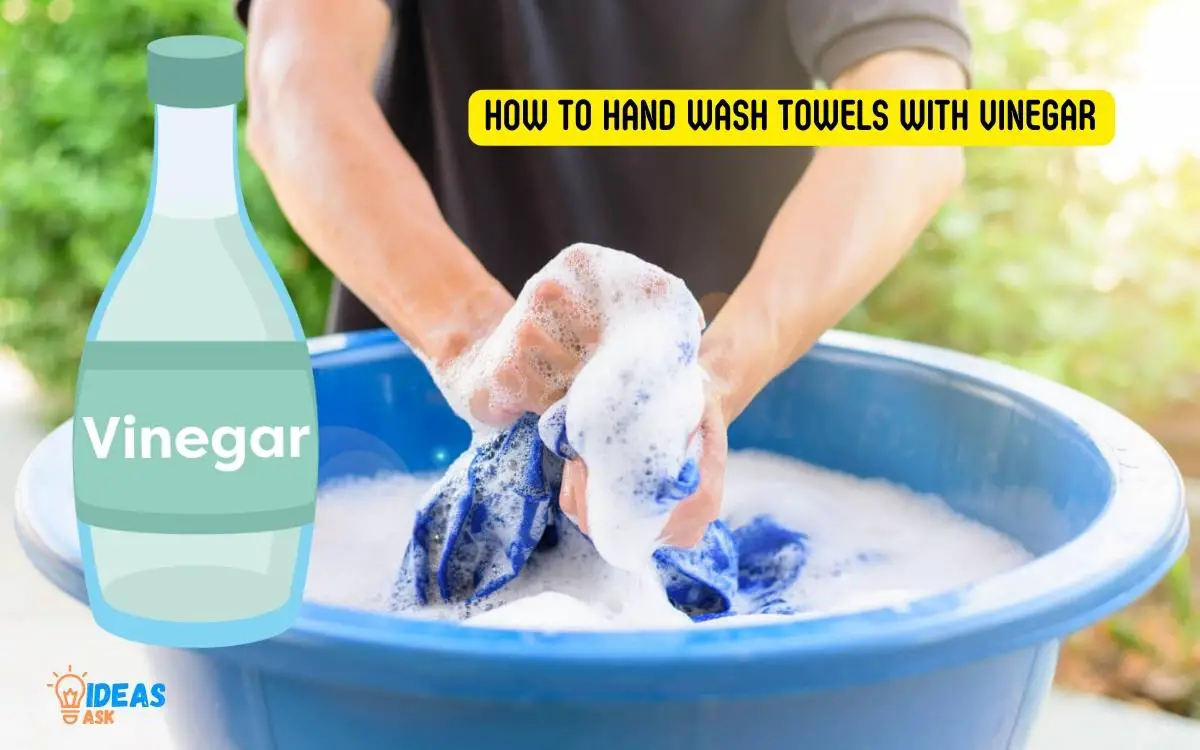How to Hand Wash Towels With Vinegar? 10 Easy Steps!
To hand wash towels with vinegar, you need to fill a sink or tub with warm water and add half a cup of white vinegar.
Then, put the towels in the water-vinegar mixture, stir around, and let them soak for about 15 to 30 minutes. After that, scrub the towels, rinse with water, and hang them for air drying.
Vinegar is a natural softener that removes soap residue, reduces static cling, and restores the absorbency of the towels.
It helps in breaking down detergent or soap build-up, which often makes the towels hard. Plus, vinegar can eliminate any foul smells and leave your towels fresh and clean.
To keep your towels in the best possible condition, hand washing them with vinegar is a great solution.
The acetic acid in vinegar helps to break down mineral deposits and dissolve soap residue, returning your towels to their original softness and absorbency.
Plus, it’s an eco-friendly and cost-effective method that anyone can do at home. So give your towels a rejuvenating wash with vinegar!

Key Takeaway
Step 1: Preparing The Towels For Washing
Prepare your towels for washing by hand with vinegar, a natural and effective solution. This technique leaves towels fresh and clean without the need for harsh chemicals.
When it’s time to give your towels a thorough hand wash with vinegar, there are a few steps you should follow to ensure the best results. Before you begin, gather all the towels you want to wash and set up your washing area.
Here’s how to prepare the towels for washing:
Sorting The Towels By Color:
- Separate the towels into different piles based on their colors: Whites, light colors, and dark colors.
- This will prevent the colors from bleeding onto each other during the wash.
Removing Any Stains Or Spots:
- Inspect each towel carefully for any stains or spots.
- Treat any stains by applying a small amount of stain remover directly on the affected area.
- Gently rub the stain remover into the fabric using your fingertips.
- Let the stain remover sit for a few minutes before proceeding to the next step.
Shaking Out Excess Dirt:
- Take each towel and give it a good shake to remove any loose dirt or debris.
- Hold one end of the towel firmly and vigorously shake it to dislodge any particles.
- Repeat this process for all the towels, making sure to shake them outside or over a trash can.
By following these steps, you’ll ensure that your towels are properly sorted by color, any stains or spots are treated, and any excess dirt is removed. This will help prepare the towels for the hand wash process with vinegar, ensuring they come out clean and fresh.
So let’s move on to the next step of hand washing the towels with vinegar.
Step 2: Creating The Vinegar Solution
To create the vinegar solution for hand washing towels, simply mix equal parts vinegar and water in a large bowl or basin. Stir the solution well to ensure it is thoroughly combined.
Mixing Warm Water And Vinegar In The Sink Or Basin
When it comes to hand washing towels with vinegar, creating the vinegar solution is a crucial step.
Follow these simple instructions to ensure you get the right mixture:
- Fill your sink or basin with warm water. Make sure it’s enough to completely submerge your towels.
- Add vinegar to the water. The ideal vinegar to water ratio is 1: 4. This means you should use 1 cup of vinegar for every 4 cups of water.
- Stir the mixture gently to ensure the vinegar is evenly distributed in the water.
- Place your towels in the vinegar solution and let them soak for about 30 minutes. This will allow the vinegar to penetrate the fibers and break down any residue or odors.
Is an essential part of hand washing towels. Following the correct vinegar to water ratio ensures that your towels get the best possible clean.
So, let’s move on to the next step and learn about determining the vinegar to water ratio, shall we?
Step 3: Hand Washing The Towels
Learn how to effectively hand wash towels using vinegar, a natural cleaning agent that can remove dirt and odors while keeping your towels soft and fresh. Discover the simple steps to achieve clean and hygienic towels without the need for harsh chemicals.
Hand washing your towels with vinegar is an effective way to keep them clean and fresh.
Follow these steps to ensure a thorough and efficient process:
Submerging The Towels In The Vinegar Solution:
- Prepare a solution by mixing equal parts of vinegar and warm water in a basin or sink.
- Immerse the towels in the vinegar solution, ensuring they are completely submerged.
- Leave the towels to soak for at least 30 minutes. This allows the vinegar to penetrate the fabric and remove any buildup or odors.
Gently Agitating The Towels To Remove Dirt:
- After soaking, begin gently agitating the towels by swishing them back and forth in the vinegar solution. This motion helps to loosen dirt particles and stains.
- To avoid damaging the fibers, be gentle during the agitation process. Remember, the goal is to remove dirt, not cause excessive wear.
Paying Extra Attention To Heavily Soiled Areas:
- While agitating, pay special attention to heavily soiled areas such as stains or spots. Use your fingers or a soft brush to gently rub these areas to ensure thorough cleaning.
- The vinegar solution will help break down dirt and grime, making it easier to remove. Take your time and make sure each heavily soiled area is treated properly.
By following these simple steps, you can hand wash your towels with vinegar effectively. Remember to rinse the towels thoroughly with clean water after washing to remove any remaining vinegar smell. Allow them to air dry or tumble dry on a low heat setting for soft, fresh towels.
Keep in mind that vinegar is compatible with most types of towels, but it’s always a good idea to check the care label for any specific instructions.
Step 4: Rinsing And Wringing Out The Towels
To hand wash towels with vinegar, start by rinsing and wringing them out thoroughly after soaking in the vinegar solution. This helps to remove any remaining residue and leaves your towels fresh and clean.
After letting the towels soak in the vinegar solution for the recommended time, it’s time to move on to the next step: rinsing and wringing out the towels. This crucial step will ensure that your towels are thoroughly cleaned and ready for use.
Follow the instructions below to properly rinse and wring out your towels:
Draining The Vinegar Solution:
- Carefully lift the towels from the vinegar solution, allowing any excess liquid to drip back into the container.
- Avoid squeezing or wringing the towels at this point, as it can cause the vinegar solution to splatter.
Rinsing The Towels With Clean, Warm Water:
- Fill a clean sink or basin with warm water. The temperature should be comfortable to touch.
- Submerge the towels in the warm water and gently agitate them to loosen any remaining residue.
- Leave the towels in the water for a few minutes, allowing the clean water to flush out the vinegar solution.
Carefully Wringing Out Excess Water:
- With clean hands, lift each towel from the water and squeeze out the excess water.
- Be gentle while wringing out the towels to avoid damaging the fabric fibers.
- Ensure that you wring out the towels thoroughly but leave them slightly damp. Over-wringing can lead to excessive drying and potential damage to the towels.
Remember, rinsing and wringing out the towels properly is essential for effective cleaning and maintaining the quality of your towels. Follow these steps diligently to ensure that your towels come out fresh, clean, and ready to be used again.
Step 5: Drying The Towels
Hand washing towels with vinegar is an effective way to remove odors and refresh their absorbency. After rinsing, dry them thoroughly to prevent mildew growth.
Hanging The Towels To Air Dry
After hand washing your towels with vinegar, it’s important to properly dry them to maintain their quality and freshness.
Here’s what you need to know about hanging the towels for air drying:
- Hang the towels on a clothesline or drying rack, ensuring they are evenly spaced and not overlapping. This allows air to circulate freely around each towel, aiding in the drying process.
- To prevent towels from stretching, gently fold them over the clothesline or drying rack without using clothespins. This will help maintain their shape as they dry.
- Leave enough space between each towel to guarantee adequate air circulation. Crowding or overlapping the towels can lead to longer drying times and potential mildew growth.
- If you’re short on space, consider using multiple clotheslines or drying racks to ensure proper airflow around each towel.
- Remember to hang the towels in a well-ventilated area, preferably a room with good air circulation. This helps expedite the drying process and reduces the chances of unpleasant odors.
- Avoid hanging the towels in humid or damp areas like bathrooms, as this can prolong drying time and promote bacterial growth.
Avoiding Direct Sunlight To Prevent Fading
While it may be tempting to take advantage of the sun’s natural drying power, direct sunlight can cause your towels to fade over time.
Follow these tips to prevent fading:
- Choose a drying location away from direct sunlight, such as a shaded outdoor area or an indoor space away from windows.
- Sunlight can bleach the colors out of towels, resulting in a noticeable fading effect. Keep your towels vibrant and bright by avoiding exposure to direct sunlight.
- If you only have access to a sunny drying space, try covering the towels with a light-colored fabric or towel to provide some shade and protection from the sun’s rays.
- Remember that sunlight exposure can weaken the fabric fibers over time, leading to decreased durability and a shorter lifespan for your towels.
- Not only does avoiding direct sunlight help preserve the color of your towels, but it also prevents any potential shrinkage that might occur with excessive heat exposure.
Fluffing The Towels Once Dry
After your towels have thoroughly dried, it’s time to give them a little fluff to restore their softness and loftiness.
Follow these tips for fluffy, luxurious towels:
- Gently shake out each towel to loosen any stiffness and remove any remaining dust or debris.
- To restore the fluffiness, give them a good shake and a few flicks with your wrist. This helps loosen up the fibers and restores their natural bounce.
- If desired, you can also place the towels in a tumble dryer on the lowest heat setting for a few minutes. This can help restore the softness and fluffiness of the towels.
- Alternatively, you can use a fabric softener or dryer balls while drying to achieve a similar effect.
- Avoid using excessive force when shaking or flicking the towels, as this may cause damage to the fabric or result in frayed edges.
- Fluffing the towels not only enhances their appearance but also helps to separate the fibers, improving their absorbency. So, don’t skip this step!
Remember, proper drying techniques are crucial for maintaining the quality and longevity of your towels.
By hanging them to air dry, avoiding direct sunlight, and fluffing them once dry, you’ll ensure that your towels remain soft, fresh, and ready to pamper you after every use.
Step 6: Using White Vinegar Instead Of Colored Vinegars
For hand washing towels, using white vinegar instead of colored vinegars is recommended. White vinegar helps to remove dirt, odor, and bacteria from the towels, leaving them fresh and clean.
When it comes to hand washing towels, using white vinegar instead of colored vinegars can be highly beneficial.
White vinegar is a versatile and natural ingredient that helps eliminate odors, removes stains, and keeps towels soft and fluffy without leaving any residue.
Here’s why you should consider using white vinegar for hand washing your towels:
- Gentle on fabrics: White vinegar is safe to use on a variety of fabrics, including towels made from cotton, bamboo, or microfiber. Its acidic properties effectively clean and sanitize without causing damage or fading.
- Odor removal: White vinegar acts as a natural deodorizer, effectively neutralizing unpleasant smells that might accumulate in towels over time.
- Stain removal: White vinegar helps to remove stubborn stains, such as those caused by cosmetics, oils, or food spills. It can be applied directly to the stained area or added to the wash cycle.
- Softens towels: White vinegar acts as a natural fabric softener, leaving your towels feeling soft and fluffy without the use of harsh chemicals.
- Prevents residue: Unlike colored vinegars, white vinegar does not leave any residue behind on towels. This ensures that your towels remain clean, fresh, and free from any unwanted buildup.
- Eco-friendly option: Using white vinegar for hand washing towels is an environmentally friendly choice. It reduces the need for chemical-based detergents and helps minimize water pollution.
- Cost-effective: White vinegar is a cost-effective alternative to commercial fabric softeners and stain removers. A small amount goes a long way in effectively cleaning and maintaining the quality of your towels.
By incorporating white vinegar into your hand washing routine, you can avoid residue or staining on towels while keeping them looking fresh and clean. Give it a try and experience the benefits of this natural and versatile cleaning agent.
Step 7: Adding Vinegar During The Rinse Cycle In A Machine Wash
Discover a simple solution for hand washing towels using vinegar. Add vinegar during the rinse cycle in a machine wash to remove odors and leave your towels fresh and soft.
Enhancing The Cleanliness Of Towels
When it comes to keeping your towels clean and fresh, adding vinegar during the rinse cycle in a machine wash can be a game-changer.
Not only does vinegar help enhance the cleanliness of your towels, but it also removes any lingering odors, leaving them smelling as good as new!
Here’s how adding vinegar during the rinse cycle works its magic:
- Vinegar acts as a natural fabric softener, making your towels feel softer and more absorbent.
- The acidity in vinegar helps break down detergent residue and mineral build-up, which can make towels stiff and less absorbent over time.
- Vinegar’s antibacterial properties help kill odor-causing bacteria, keeping your towels fresher for longer.
- Adding vinegar to the rinse cycle can also help remove any musty or mildew smells that may have developed over time.
To effectively add vinegar during the rinse cycle:
- Use white distilled vinegar: White distilled vinegar is the best type of vinegar to use for this purpose. Avoid using any other types of vinegar, such as apple cider vinegar, as they may leave behind a scent.
- Measure the right amount: Add 1/2 to 1 cup of vinegar to the fabric softener dispenser or during the rinse cycle of your washing machine. The amount may vary depending on the size of your load and the hardness of your water.
- Run a regular wash cycle: Start your washing machine with the usual settings for your towels. Since vinegar is added during the rinse cycle, it won’t interfere with the detergent’s cleaning process.
- Enjoy fresh and clean towels: Once the wash cycle is complete, remove your towels from the machine and hang them up to air dry or tumble dry on low heat. You’ll notice a fresh scent and improved cleanliness in your towels.
Is a simple yet effective way to enhance the cleanliness of your towels, remove odors, and extend their lifespan. Give it a try and see the difference it makes!
Step 8: Using Vinegar For Different Towel Materials
Learn how to effectively hand wash towels using vinegar. This natural cleaning method helps remove odors and disinfects towels, regardless of the material type.
When it comes to hand-washing towels, using vinegar can be an effective and eco-friendly alternative to traditional detergents. Vinegar not only helps to remove dirt and stains but also eliminates odors and leaves your towels feeling fresh and soft.
However, it’s essential to consider the material of your towels before using vinegar, as different fabrics may require some adjustments in the concentration of vinegar or even avoid it altogether.
Here’s a breakdown of how to use vinegar for different towel materials:
Adjusting Vinegar Concentration For Delicate Fabrics:
For delicate fabrics such as silk or linen towels, it’s crucial to adjust the concentration of vinegar to ensure the preservation of their quality.
Use the following steps when hand-washing delicate towels:
- Mix one teaspoon of vinegar with one gallon of cool water and stir well.
- Submerge the towels in the mixture and allow them to soak for 10-15 minutes.
- Gently agitate the towels in the water to help remove any dirt or stains.
- Rinse the towels thoroughly with cool water to remove the vinegar solution.
- Squeeze out excess water and gently press the towels between clean towels to remove additional moisture.
- Hang or lay the towels flat to air dry, avoiding direct sunlight.
Avoiding Vinegar For Certain Towel Types:
While vinegar is generally safe to use for most towel materials, there are a few exceptions where it’s best to avoid using vinegar altogether.
The following towel types should not be exposed to vinegar:
- Microfiber towels: Vinegar can break down the fibers in microfiber towels, reducing their effectiveness and softness. Instead, wash microfiber towels with a gentle detergent suitable for this fabric.
- Acrylic or synthetic towels: These materials may react negatively to vinegar, resulting in color fading or damage to the fibers. Opt for a mild detergent designed for synthetic fabrics when washing these towels.
- Leather or suede-trimmed towels: Vinegar can be too harsh for leather or suede trims, potentially causing discoloration or damage. Instead, spot clean any stains on these towels using a mild soap or cleaner specifically made for leather or suede.
Remember to always check the care label of your towels before proceeding with any cleaning method, including vinegar.
By using the appropriate vinegar concentration or avoiding vinegar altogether, you can keep your towels clean, fresh, and in excellent condition.
Step 9: Removing Tough Stains With Vinegar
Vinegar is an effective solution for removing tough stains from towels. By handwashing your towels with vinegar, you can restore their cleanliness and freshness without harsh chemicals.
Towels are prone to accumulating tough stains over time, whether it’s makeup, grease, or dirt. Instead of resorting to chemical-filled stain removers, you can easily tackle these stubborn stains using vinegar.
Vinegar is a natural and eco-friendly alternative that is both effective and affordable.
Here’s how you can use vinegar to remove tough stains from your towels:
Spot Treating Stains With Vinegar Before Washing:
- Begin by identifying the areas on your towel that have tough stains.
- Apply undiluted white vinegar directly onto the stain.
- Gently rub the vinegar into the stain using a cloth or sponge.
- Allow the vinegar to sit on the stain for at least 15 minutes to maximize its effectiveness.
- For more stubborn stains, you can let the vinegar sit overnight.
- After waiting, rinse the towel with cold water to remove the vinegar and stain residue.
- Proceed to wash the towel as you normally would.
Using vinegar as a spot treatment before washing your towels can help lift and loosen tough stains, making it easier for your laundry detergent to do its job effectively.
Allowing Vinegar To Sit On Stains For Maximum Effectiveness:
- For heavily soiled towels, create a vinegar soak solution by mixing 1 part vinegar with 2 parts water in a basin or sink.
- Submerge the stained towel into the vinegar solution, ensuring that the stains are fully immersed.
- Let the towel soak for at least 30 minutes, but if the stains are particularly stubborn, leave them to soak for an hour or longer.
- During the soaking process, periodically agitate the towel by gently swishing it around in the vinegar solution.
- After the designated soaking time, remove the towel from the vinegar solution and give it a thorough rinse with cold water.
- Proceed to wash the towel in your washing machine with your regular laundry detergent.
Allowing the vinegar to sit on the stains for an extended period helps break down the molecules responsible for the discoloration, ensuring better stain removal results.
By following these methods, you can effectively remove tough stains from your towels using vinegar as a natural and eco-friendly alternative.
Remember to always test the vinegar on a small, inconspicuous area of the towel before proceeding with the stain removal process.
With a little vinegar and some patience, you’ll have your towels looking clean and fresh in no time!
Step 10: Alternatives To Vinegar For Hand Washing Towels
Discover effective alternatives to vinegar for hand washing towels. Explore natural options that are gentle on your fabrics yet deliver excellent cleansing results.
While vinegar is a popular natural option for hand washing towels, there are other alternatives available that can effectively clean and freshen your towels.
Here are some alternatives you can consider:
- Using lemon juice as a natural alternative: Lemon juice is a natural acid that can help remove stains and odors from your towels. Its citric acid content makes it a suitable substitute for vinegar. To use lemon juice, follow these steps:
- Squeeze the juice of one lemon into a bowl of warm water.
- Soak your towels in the lemon water mixture for 15-30 minutes to allow the citric acid to work.
- After the soaking time, hand wash the towels as usual.
- Rinse well to remove any residue and hang the towels to air dry.
- Trying specialized laundry soaps for specific stains: If you’re dealing with stubborn stains on your towels, using a specialized laundry soap can be an effective alternative to vinegar. These soaps are specifically formulated to tackle various types of stains, such as grease, dirt, or ink. Some options you can try include:
- Stain-removing laundry detergents: These detergents are designed to target specific stains, making them ideal for treating tough marks on your towels.
- Enzyme-based laundry detergents: Enzymes in these detergents break down proteins, fats, and carbohydrates in stains, making them easier to remove.
- Oxygen bleach: This type of bleach can be used on colored towels and is effective at removing stains without causing fading or damage.
Remember to always follow the instructions on the packaging when using specialized laundry soaps to ensure proper usage and optimal results.
By exploring these alternative methods, you can find the best approach to hand washing your towels that suits your preferences and needs. Experiment with different options to discover what works best for you.
Conclusion
After following these simple steps, you can enjoy fresh and clean towels with the help of vinegar. Hand washing your towels with vinegar not only removes odors and bacteria but also helps to keep them soft and absorbent.
The acidity in vinegar acts as a natural fabric softener, leaving your towels feeling plush and fluffy. With its antimicrobial properties, vinegar eliminates germs and prevents mildew growth, prolonging the life of your towels.
Additionally, using vinegar as a part of your laundry routine is an eco-friendly and cost-effective alternative to harsh chemicals. So, the next time you find yourself needing to wash your towels, remember to reach for that bottle of vinegar.
Your towels and the environment will thank you. Say goodbye to dull, smelly towels and say hello to fresh, clean, and soft ones.






